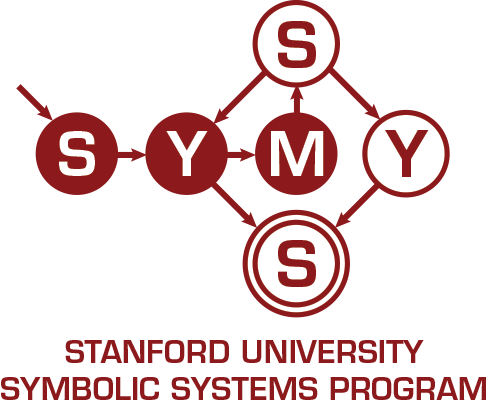Symbolic Systems Major Concentrations (5 course versions)
[Updated October 7, 2015 - deleted note about missing course data]
In addition to the core, SSP majors choose an area of concentration. For undergraduates completing the Generation 3 Core Requirements (versions 12 and later), a concentration comprises an approved list of five courses of three or more units each. Those who are completing the Core Requirements (version 11 or earlier) for Bulletin years 2001-2002 through 2010-2011 must complete a six course Concentration. The concentration lists linked below are five course versions, and only apply to majors doing the 2011-2012 and later Core requirements.
NB: A particular version of the requirement lists (Core or Concentrations) may only be used by students who declare prior to the date of the version that succeeds it. A student may use any version introduced after the date of their declaration prior to the completion of their degree.
There is far greater flexibility in the make-up of a concentration than there are in the core requirements, which are quite strictly upheld. Our primary concern is that students identify an area of particular interest within the general sphere of SSP's subject matter, and design a coherent set of courses around this. They can do so in consultation with the student Advising Fellows, their Faculty Advisors, the Director, or the Associate Director. A list of suggested potential advisors for each concentration is available here. To guide students in their selection, SSP faculty members have drawn up suggested concentrations, which students may elect to follow precisely or adopt with limited changes approved on an individual basis by the Director or the Associate Director. Alternatively, students may design their own concentrations from scratch (see the last paragraph below).
The suggested concentrations are:
Decision Making and Rationality,
Neurosciences, and
For a list of applicable courses within each concentration, click on the links above. Frequently, courses listed under each concentration serve as examples only, so that unlisted courses, covering similar material, could be substituted for them. Students should discuss course selection with their advisors, and carefully look through the Stanford Bulletin for the most relevant current offerings.
Note: A course may not count toward both a core and a concentration requirement, unless it is applied to the Advanced Small Seminar area within the core. A course that is applied to the Advanced Small Seminar requirement may also be counted toward a student's concentration or toward another core requirement, if appropriate, but not to both.
Individually Designed Concentrations (IDCs) consist of five courses in a coherent subject area related to symbolic systems. This relationship may be established through inclusion in an IDC of two or more courses that connect the proposed concentration to the core, i.e. courses that (a) directly apply disciplines included in the core and (b) are related by topic or methodology to the other courses in the proposed concentration.
Course selection is to be made in consultation with the student's advisor and is subject to approval by the advisor, the Associated Director, and the Director. For examples of IDCs completed by past SSP students, consult the list of alumni and apply the filter "Individually Designed Concentration".
Approval of an IDC must take place no less than two full quarters before a student plans to graduate, e.g. prior to the first day of Winter Quarter of the senior year if a student intends to graduate in June of that year. Failure to obtain approval by the required date will necessitate either completing the requirements for one of the suggested concentrations, or delaying graduation to the end of the second full quarter following approval of an IDC.
To get a proposed IDC approved, send an email message to symsys-directors at lists.stanford.edu, cc'd to your prospective concentration advisor, stating that the advisor has approved your proposal, and giving a title, one-paragraph description, and course plan for your proposed concentration.

 Concentrations (5 course versions)
Concentrations (5 course versions)